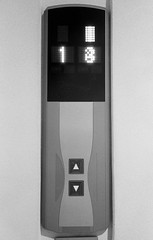I have trouble with elevators. Or, more specifically, with elevator buttons. Not the ones inside the elevator but the ones outside, the ones you push when you want the elevator.
Some elevators have just one "come here" button. Busier elevators often have an "up" and a "down" button, like in the image to the left. The idea is that you tell the elevator where you want to go - up, or down - and it will come and pick you up.
Why not have just a single button? Because a busy elevator is much easier to control - where should I stop and who do I pick up next - if you know which way people are going on each floor. You don't want to stop for somebody going up when you're on the way down to the ground floor.
What's my problem? My problem is, I keep pressing the wrong button. If I think about it, I know I'm supposed to tell the elevator where I want to go. But that's not how my mind sees it. My brain knows that I'm on the first floor, and sees that the elevators are up on some higher floor, so it wants to press the down button, to get an elevator to come down here.
Some elevators have just one "come here" button. Busier elevators often have an "up" and a "down" button, like in the image to the left. The idea is that you tell the elevator where you want to go - up, or down - and it will come and pick you up.
Why not have just a single button? Because a busy elevator is much easier to control - where should I stop and who do I pick up next - if you know which way people are going on each floor. You don't want to stop for somebody going up when you're on the way down to the ground floor.
What's my problem? My problem is, I keep pressing the wrong button. If I think about it, I know I'm supposed to tell the elevator where I want to go. But that's not how my mind sees it. My brain knows that I'm on the first floor, and sees that the elevators are up on some higher floor, so it wants to press the down button, to get an elevator to come down here.
And really, it makes much more sense. After all, when an elevator has only one button that button tells the elevator "come here". If we have two buttons with arrows, they naturally mean "go up" or "go down". Also, we have to tell the elevator where we want to got once we get inside; having to tell it when outside too is redundant, wasteful, repetitive.
I'm not the only one. I've started to take note of what other people do, and from time to time I do see them press the obviously wrong button. The design is not optimal, in other words, and suggests the wrong action for at least some users some of the time.
It's not easy to figure out how to improve it, though. The benefits for elevator scheduling are so large that using just a single button isn't feasible for busy systems. I have no idea how to improve the button layout and design to avoid this either. Perhaps the best solution simply is to fail gracefully; make sure it's easy to reverse the travel direction and otherwise make sure nobody gets too inconvenienced with the inevitable wrong button press.


Hi,
ReplyDeleteit's clear that one button is not a solution, like you said. I have thought of one solution though. You said:
"My brain knows that I'm on the first floor, and sees that the elevators are up on some higher floor, so it wants to press the down button, to get an elevator to come down here."
What if there were no displays outside, only two arrow buttons? This way you don't know where the elevator is, and you're not going to want to tell the elevator to come down/up. You only want to tell the elevator where you want to go: up or down.
Imi
Innovative solution. I doubt that would work, though. The problem really is that we internalize that "buttons tell the elevator what to do". And without a display we're likely to simply get confused about what button to press instead.
ReplyDeleteBesides, those displays are there for a reason. The feedback on elevator position does a lot to reduce the frustration and shorten the subjective waiting time for the users. You remove the display and people will find your elevators to be frustratingly slow - even though the actual waiting time doesn't change a bit.
Take the stairs, Janne.
ReplyDelete"Take the stairs, Janne."
ReplyDeleteBut they go both up and down. There's no online help nor any tooltips. What should I do? ^_^
Not sure. Perhaps walk backwards on one of those slow-moving conveyor belts folk insist on sticking in airports would relieve the tension. May have a go tomorrow, have a drop off at Narita to do.
ReplyDeleteMaybe the solution would be to have the list of floors available (similar to the inside of the elevator), which would allow both clearer intention (I want to go to floor 7, not simply "up") and possibly better scheduling (because the elevator has distance information too, not just direction).
ReplyDeleteThat'd be doable. Of course, it'd mean a larger - more expensive and harder to fit - panel at every floor. And I've actually seen that a couple of times in high-rises. I guess the improved scheduling makes the extra cost worth it.
ReplyDeleteFor more normal elevators, though, I suspect good error recovery is probably the best course.